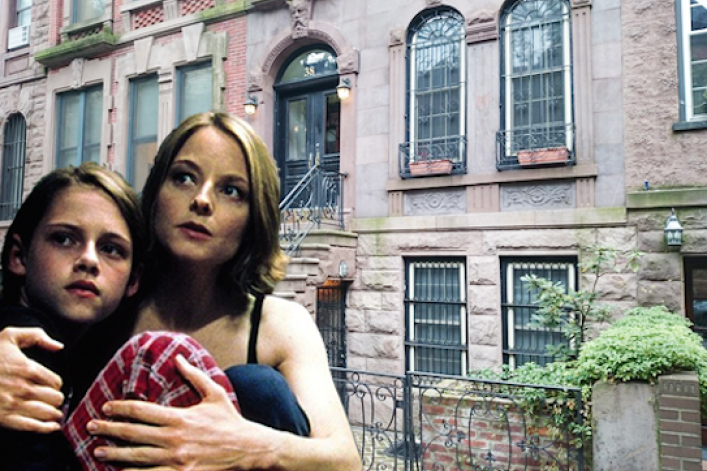The real point of 'The Panic Room' —never move into a brownstone with a 'valuable' secret room?

When a movie or TV show is set in New York City—and if the people making it are savvy—real estate becomes part of the story itself. In Reel Estate, we look at some of the more memorable domiciles to grace the screen.
When we think of wasted real estate these days, it's generally with an eye to massive condos owned by mysterious foreign billionaires—and left to sit empty for most of the year. But maybe even owning a brownstone you don't technically need is tipping past the point of ethical home-owning behavior?
After a recent re-watching, that sort of seems to be the hidden moral to 2002's The Panic Room, wherein a newly divorced (and newly wealthy) Jodie Foster gets talked into buying a cavernous Upper West Side brownstone, only to be terrorized by the grandson of its wealthy former owner. Long story short (and spoiler alert): millions and millions of dollars are hidden in the panic room.
When it first came out, New York Times critic A.O. Scott correctly dubbed the film a "Manhattan luxury real estate thriller," noting, "these pictures both incite class resentment and soothe it."
Seems like a harsh penalty for a slightly outsized home purchase, but in any case, let's back up a bit. The movie opens with Jodie Foster's character Meg and a friend hurrying to an open house on the Upper West Side. "It's 4,200 square feet, has four floors, a courtyard, and south-facing garden in the back," her friend fills her in.


When they arrive, the broker informs them that the place was built in 1879, and "is a cross between a brownstone and a townhouse—we like to call it a townstone." (We've never heard this term before, and hope to never hear it again.)
Also, thanks to a wealthy, elderly former owner, it's got a working elevator, a rarity for such an old property. Meg protests that the place costs a fortune, and her friend reminds her that she can afford it, while her daughter Sarah (Kristen Stewart) points out, "This isn't Barney's. You don't have to pay the price on the tag." (Unclear how a tween from Greenwich knows so much about New York bidding strategy, but fine. Bet that tween would now be a real estate agent.)




Other than the inexplicably dim lighting (no one seems to turn on the lights in this place for the entire course of the film), it is an incredible house—huge stairwells, high ceilings, lots of prewar details like crown moldings and a huge soaking tub we briefly see in the master bathroom. Most of it, however, is a sound stage. Only the exterior was shot on location, at 38 West 94th Street, a home that's apparently been divvied up into rentals; a two-bedroom in the building rented last fall for $3,350/month, per StreetEasy.
As for the eponymous panic room, it's hidden behind wall in the master bedroom, and ends up coming in pretty handy when the ex-owner's grandson Junior (Jared Leto) and two henchman break in on their very first night home. (They moved in earlier than anticipated, as Junior assumed the 14-day escrow period meant 14 business days.)
Suffice it to say all hell breaks loose, and while the movie isn't exactly convincing as far as their merits, the Times reported as recently as this May that panic rooms are still a popular option with certain wealthy buyers, though more often disguised as walk-in closets rather than austere metal bunkers, and more commonly referred to as "safe rooms." (The term "panic room" was apparently just coined to add drama to the movie.)
As for Meg and Sarah, at the end, we see them on a peaceful bench in Central Park, cruising listings for Upper West Side apartments, not houses, and strictly avoiding anything larger than a two-bedroom. So, lesson learned?
Related:
Reel Estate: Single White Female is more realistic than you thought
Is home security system Canary worth a try?
'Odd Mom Out' Managed to make the UES look more appealing than Brooklyn



























